In recent years, there has been a significant surge in interest towards holistic and alternative treatments to address a variety of health concerns. This surge is largely driven by a growing awareness and understanding of the benefits of such treatments, as well as an increasing desire to explore healing methods outside of mainstream medicine. Among the many alternative treatments that have caught the attention of health enthusiasts and professionals alike, light therapy has emerged as an especially promising approach. It has begun to draw attention particularly for its potential benefits in improving vision and overall eye health. This article will take a comprehensive look at the concept of light therapy, delving deeply into its origins, its principles, and the science that supports its use. It will also explore the specific effects of light therapy on vision, discussing both the benefits and potential risks. Finally, it will provide practical advice on how you can incorporate light therapy into your daily routine, offering tips for safe and effective use. By understanding light therapy in depth, you can make an informed decision about whether it might be a beneficial addition to your personal health and wellness regimen.
Concept of Light Therapy
Light therapy, which is also commonly referred to as phototherapy, is a treatment methodology that involves the deliberate exposure of the body to specific wavelengths of light. The process utilizes a variety of light sources, including lasers, light-emitting diodes (LEDs), fluorescent lamps, dichroic lamps, or extremely bright, full-spectrum light, all of which are carefully calibrated to emit the correct wavelength. The duration of exposure is also meticulously prescribed, ensuring the treatment is delivered effectively. What makes this treatment method particularly appealing to many is its non-invasive nature. Light therapy has been found to be an effective treatment for a wide variety of conditions.
Among its most recognized uses is the treatment of Seasonal Affective Disorder (SAD), a type of depression that occurs during specific seasons, most commonly in winter. Additionally, light therapy is increasingly used to regulate circadian rhythms, improve sleep quality, boost energy levels, and reduce symptoms of insomnia or jet lag. Dermatological applications such as managing acne, eczema, and psoriasis have also shown promising results. Furthermore, in recent years, researchers have begun exploring the potential benefits of light therapy for eye health, particularly in managing conditions like age-related macular degeneration (AMD) and digital eye strain caused by prolonged exposure to screens. As the science evolves, light therapy continues to gain popularity for its versatility, safety, and drug-free approach to improving both physical and mental well-being.

It has been used to treat skin disorders, including psoriasis, acne vulgaris, eczema, and neonatal jaundice. It is also used to regulate sleep problems, especially those stemming from circadian rhythm disorders. As such, it has proven to be an important tool in the management and treatment of a variety of conditions, offering a non-invasive and relatively risk-free option for patients.
The Mechanics of Light Therapy
The process of light therapy, also known as phototherapy, is a rather straightforward one. It is a therapeutic technique that leverages the principle that exposure to certain specific wavelengths of light has the capability to trigger distinct biological responses within the body. This principle is hinged on the fact that our bodies can absorb these light wavelengths through both the skin and the eyes. Upon absorption, these wavelengths instigate a series of chemical reactions within the body's cells. These reactions are highly beneficial as they can stimulate a healing response, which can aid in the recovery of various physical ailments. Moreover, they can alleviate pain, making it an effective non-pharmacological pain management strategy. Additionally, they help in increasing blood flow, which aids in the delivery of nutrients and oxygen to different parts of the body, promoting overall health. Lastly, they can potentially reduce inflammation, which is particularly beneficial in managing chronic inflammatory conditions.
Light Therapy: A Vision Enhancer
Over the past few years, there has been a growing interest in the potential of light therapy to enhance vision. The human eye is naturally receptive to light, making it an ideal target for this type of therapy. When targeted light therapy is applied, it can stimulate the cells in the eyes. This stimulation can, in turn, promote the overall health of the eyes. This method of treatment could potentially lead to significant improvements in vision, potentially changing the lives of those who suffer from poor eyesight. As research continues, it is hoped that the benefits of light therapy for vision will become even more apparent, leading to greater adoption of this innovative treatment approach.
The Role of Light Therapy in Vision Improvement
Light therapy, which is a therapeutic method that utilizes specific wavelengths of light, can greatly help in the regeneration and restoration of the cells in the retina. This, in turn, can significantly improve the eye's ability to focus and respond to light stimuli effectively. This ability to focus and respond to light is crucial in maintaining good eye health and vision. If this ability is compromised, it can lead to a variety of vision problems. Therefore, light therapy can play an essential role in preventing or alleviating these issues. This treatment can be particularly beneficial for those suffering from conditions that affect the retina. One such condition is age-related macular degeneration, a common eye disorder that affects the central part of the retina known as the macula, leading to a loss of central vision. Hence, light therapy can be a potential treatment option that could improve the quality of life of those living with such conditions.
Eye Benefits from Light Therapy
Light therapy, a treatment method that exposes you to doses of specific kinds of light, has been found to be effective in reducing eye strain, a prevalent problem in our current digital age where screens have become an integral part of our lives. Whether it's for work or leisure, individuals are spending a significant amount of time in front of screens which can lead to prolonged strain on the eyes. This strain can cause discomfort and can negatively affect one's quality of life. However, regular exposure to light therapy can help ease this strain. By consistently incorporating light therapy into your routine, you can significantly improve the overall comfort of your eyes, thus enhancing your screen-time experience and maintaining your eye health in the long run.
However, regular exposure to light therapy can help ease this strain by promoting better ocular blood circulation, balancing melatonin levels, and resetting circadian rhythms. In particular, blue-enriched white light has been shown to increase alertness and reduce visual fatigue during extended screen use. Moreover, light therapy has also demonstrated potential in supporting retinal health and slowing down age-related visual decline, especially when used consistently over time.
Incorporating light therapy into your daily routine doesn't just reduce discomfort—it offers a wide range of science-backed benefits for your eyes. Here are some of the most compelling positive effects:
Light therapy reduces digital eye strain caused by prolonged screen exposure.
It enhances blood circulation in the eyes , supporting retinal nourishment and overall eye health.
Light therapy helps regulate melatonin production , improving sleep quality and reducing eye dryness.
It boosts focus and mental clarity , helping reduce eye fatigue during long work hours.
Studies suggest light therapy may slow age-related vision decline , promoting long-term eye wellness.
Practical Light Therapy Applications for Eyes
Light therapy is an effective, accessible treatment option that can be seamlessly integrated into your daily routine. It's a non-invasive, painless treatment that requires no recovery time, making it an ideal choice for many individuals. This therapeutic approach can be performed in the comfort of your own home, given you have the appropriate equipment. It offers the flexibility to carry out your treatment at a time that suits you, without the need for hospital visits or appointments with healthcare professionals. The convenience and effectiveness of light therapy make it an increasingly popular choice for many.
Light therapy is an effective, accessible treatment option that can be seamlessly integrated into your daily routine, offering numerous practical benefits for those seeking to improve eye comfort and overall visual well-being. As a non-invasive and painless form of therapy, it requires no downtime or recovery period, which makes it exceptionally convenient for both busy professionals and individuals with limited mobility. Whether you're looking to combat digital eye strain from prolonged screen exposure or alleviate symptoms related to seasonal affective disorder (SAD), light therapy provides a gentle yet powerful solution.

How to Use Light Therapy for Vision Improvement
For optimal outcomes, it's recommended that light therapy should be undertaken in a consistent manner, preferably on a daily basis. This is because the consistent exposure to light helps regulate your body's internal clock, improving your mood and sleep quality. Devices specifically designed for light therapy, such as light therapy glasses, have been crafted with the user's convenience in mind. They are lightweight, portable, and can be comfortably worn while going about your regular daily tasks. This means that you can easily incorporate light therapy into your routine, whether you're working at your desk or doing household chores. It's an easy and effective way to boost your wellbeing.
Potential Side Effects and Precautions
Light therapy, a treatment approach that has gained recognition over the years for its effectiveness in managing certain health conditions, is generally considered safe for most individuals. Nevertheless, like any other form of treatment, it is always the wisest course of action to consult with a healthcare provider or a professional in the field before commencing the treatment process. This is to ensure that the therapy aligns with your current health status and to avoid any potential complications. Some individuals may encounter mild side effects in the wake of initiating light therapy. These side effects can range from eye strain, which is usually due to exposure to bright lights, to headaches that may be triggered by the therapy. However, these side effects are usually temporary and tend to subside once the body adjusts to the new treatment regimen. Importantly, always remember to communicate any discomfort or concerns to your healthcare provider to ensure a safe and effective treatment process.
Light Therapy Devices for Eyes
Various innovative devices are now accessible for conducting light therapy right in the comfort of your own home. These devices are tailored for individuals who wish to engage in this form of treatment without the need to visit a specialist. Among these, one of the most popular and highly effective devices that stands out is the Luminette 3 Light Therapy Glasses. Renowned for their efficiency, these glasses have been designed with precision to deliver optimal results for users seeking the benefits of light therapy.
Thanks to their compact and user-friendly design , the Luminette 3 glasses allow users to go about their normal routines while receiving their daily dose of therapeutic light. Whether you're working at a desk, enjoying your morning coffee, or getting ready for the day, these glasses provide discreet and effective treatment without disrupting your schedule.
Moreover, the adjustable brightness settings ensure a customized experience based on your sensitivity and lifestyle needs. The device mimics natural daylight, helping to regulate circadian rhythms, reduce symptoms of seasonal affective disorder SAD , combat winter blues , and improve sleep quality . With clinical validation and thousands of satisfied users, Luminette 3 is a trusted companion for anyone seeking to integrate light therapy into their wellness routine with ease and confidence.

The Luminette 3 glasses are a third-generation wearable light therapy device, scientifically designed to simulate the effects of natural daylight and support your body's circadian rhythm. With a lightweight, glasses-like design, you can wear them while reading, working, cooking, or commuting — no need to sit in front of a lamp.
The Luminette Drive is a specialized version of the glasses, designed for drivers who often experience sleepiness, low energy, or sluggishness behind the wheel. Whether you're commuting early in the morning, working night shifts, or battling drowsiness on long drives, Luminette Drive helps you stay alert and focused.
Conclusion
The use of light therapy as a method for improving vision is an exciting and promising field of study. This innovative approach has the potential to revolutionize how we view eye health and vision enhancement. One of the standout products enabling this development is the Luminette 3 Light Therapy Glasses. These glasses provide an at-home solution, making the process significantly more accessible and convenient for consumers. With the ability to use the device in the comfort of your own home, maintaining eye health and potentially improving vision is no longer a complex process. This could usher in a new era of vision care, making it easier than ever for individuals to take control of their eye health.
FAQ
What is light therapy for eyes?
Light therapy for eyes involves exposure to daylight or specific wavelengths of light using polychromatic polarised light, for a prescribed amount of time each day.
What are the benefits of light therapy for eyes?
Light therapy can help regulate the body's internal body clock, improve mood, increase alertness and productivity, as well as aid in better sleep.
Is light therapy for eyes safe?
Yes. Light therapy is generally safe. However, it is advised to consult with a healthcare professional before starting any new treatment. Always follow the manufacturer’s instructions to use light therapy products safely.
Can light therapy with Luminette help reduce screen-related eye strain
Yes, regular use of Luminette can help alleviate digital eye fatigue by enhancing visual comfort and supporting natural melatonin cycles, which are often disrupted by screen time.
Is Luminette suitable for people with light sensitivity or existing eye conditions?
While Luminette uses a safe light spectrum, we always recommend consulting your eye care professional before starting therapy, especially if you have a diagnosed eye condition or high light sensitivity.

























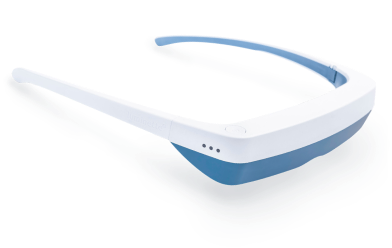
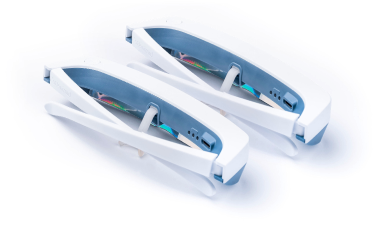
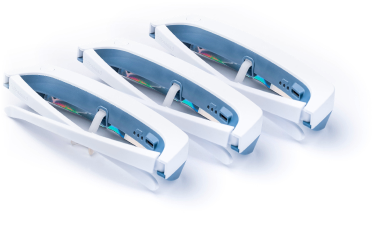

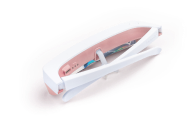
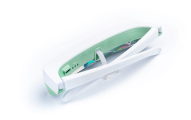

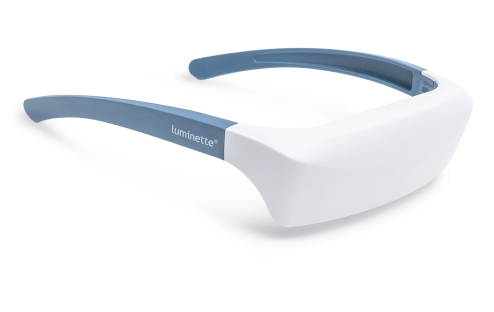
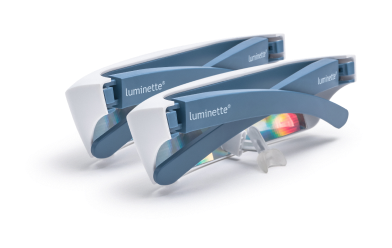
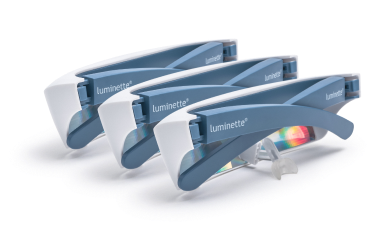




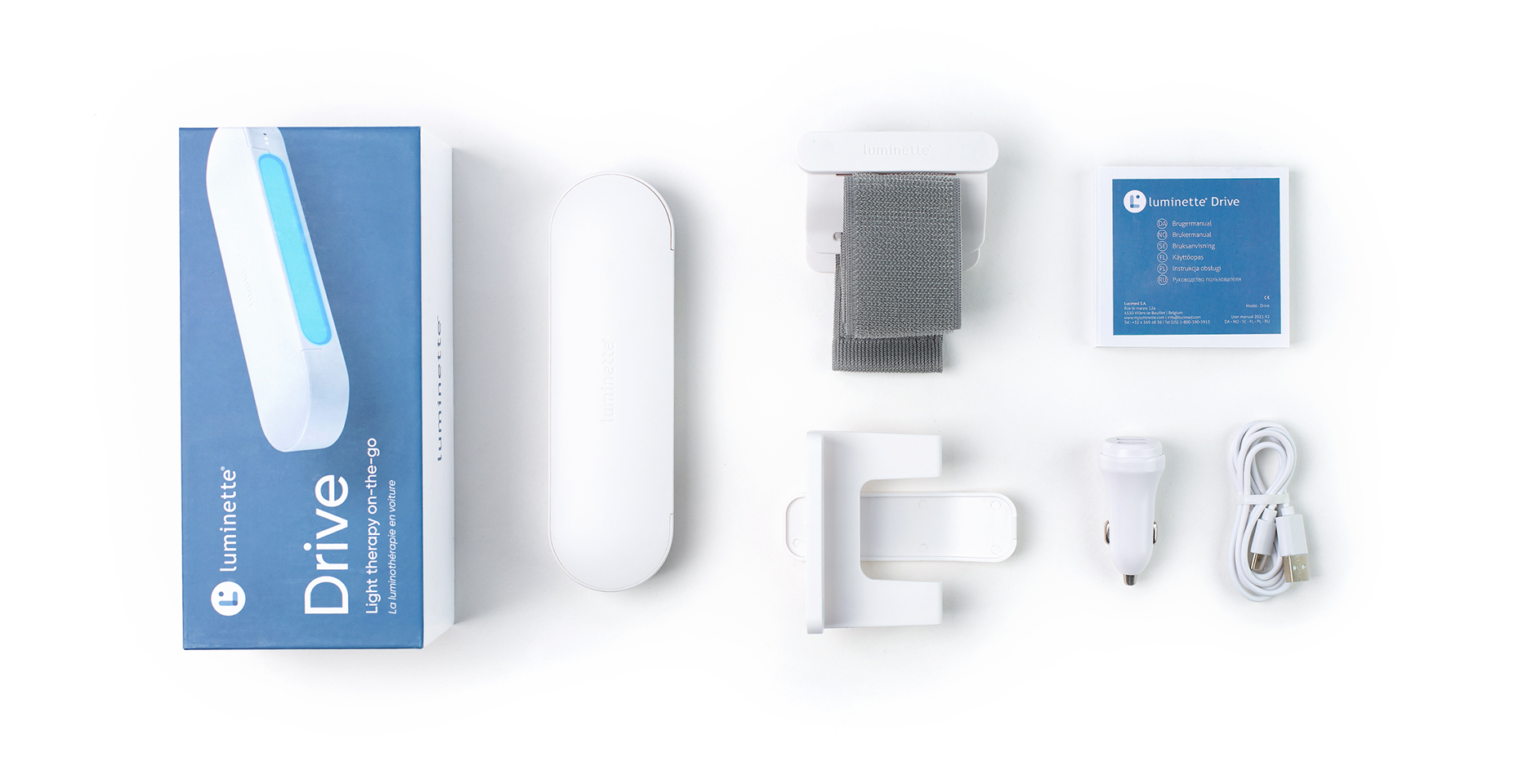

 Please note
Please note 













